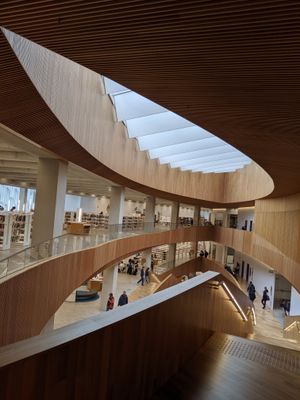Of the big Internet age companies, Microsoft is in many ways the most interesting. It has to find a way of straddling its desktop legacy and the new world of web services. In this context, the recent presentation by Ray Ozzie, Microsoft’s newly elevated Chief Software Architect, at the MSFT financial analyst meeting is very interesting. It has had a mixed reception.
Here are some of the thoughts that struck me reading it.
He talks about the ‘cheap’ revolution which has enabled massivly centralized computational and storage capacity, rich and powerful ‘edge’ devices on the network, and high-speed connections between them.
He suggests that an internet service world has two aspects. The first is an ‘architectural principle’ where the network enters applications so that they may be distributed across centralized servers and edge devices. His formulation of the second, the ‘web-based value delivery model’ is more interesting:
Individuals on the Web, armed with nothing more than a browser and a search engine and word of mouth, discover new products and services of all kinds. They try them, they buy them, they experience them, recommend them, they maintain their vendor relationships online. Neither stand-alone products nor stand-alone marketing and sales models are quite as relevant in this new world. Whether it’s a product targeting the consumer, the enterprise, or any other customer in between, the user is now in control on the Net. And so, regardless of where we came from as an industry or as a company, moving forward we must frame all our products and services from an online connected end-user perspective. [MSFT Financial Analyst Meeting: Ray Ozzie]
He reminds the audience of the benefit of placing developments in the context of increasingly intertwined digital workstyles and lifestyles.
What is the direction for Microsoft in this world? He talks about the development of Microsoft Live as a ‘services platform’ and ‘experience hub’, and of the various devices and Microsoft applications as ‘experience delivery’ venues. In this way they aim to develop seamless experiences across the desktop and other devices and the centralized Microsoft platform. (He remains relatively quiet about seamlessness with non-Microsoft environments.)
One of the more interesting aspects of this outline is that it is shifting the main Microsoft ‘platform’ focus from the desktop to the network. The advantages of this are that it enables greater sharing (where users can share stuff – calendar entries for example – centrally), greater concentration of shared capacity (individual services, database, e-commerce, storage, etc) which be leveraged by delivery environments, and so on. For example, he talks about how the xBox Live service “utilizes the power of the Windows Live platform for federated identity and points and payments and more”. This creates interesting issues about the balance of activity across the network, beteen centralized services and various edge points.
A major aspect the central platform is what Ozzie calls optimization.
But beyond infrastructure services, what’s most unique and valuable about a very large-scale services platform is what I’ll refer to as optimization. By optimization I mean the monitoring and utilization of both collective end-user behavior and individual behavior to rank content for the user. That ranked content might be the order of advertisements in a search or e-mail window, or the order of relevant news items or playlists or video clips or items in a marketplace that are presented to the user.
This is about the collection of what I have called intentional data, and has become a central feature of internet services which adapt and are refined based on the tracks of usage and users.
Ozzie goes on to describe three metrics. First is the number of service-connected applications, which ‘naturally and organically attract users and increase usage’. This is an interesting claim, which goes back to the ‘web-based value delivery model’. Second is the strengthened ability to ‘optimize our offerings’ using the aggregated data collected on the platform (while respecting, he is careful to note, end-user privacy). And third is increasingly seamlessness of the experience.
He also discusses some other metrics around growth and numbers, including the following:
This is important because we’ll work intentionally to increase the amount of primary attention that users give to our services and service-connected offerings. We’ll monitor the ecosystem growth rate in terms of advertisers as well as the number and quality of partner applications and syndicated Web sites connecting into our services platform. We’ll monitor the application attach rate: that is, the stats indicating how many users utilize multiple applications, whether desktop, mobile or Web. [MSFT Financial Analyst Meeting: Ray Ozzie]
And there is more.
I have quoted this at some length because it touched on more general issues at so many points. Clearly, this is a story about a particular platform play but what Microsoft does is important.
And how to restructure for working in a network environment is an issue for us all. In particular, over the next few years the library community will increasingly grapple with questions about what to move into shared platform services, what to do locally, and what organizational and structural contexts will tie it all together.
Related entries:
Updated: oops .. forgot to put in links to the transcription of Ray Ozzie’s talk. They are now in.




